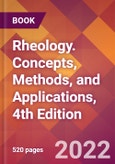The fourth edition of this excellent book, used by many universities and companies for teaching and research purposes, brings significant current information on new methods and applications based on recently published literature. The most notable new sections discuss non-Newtonian properties and their effect on material processing, heterogeneity in flow, rheology of highly concentrated emulsions and suspensions, viscosity and viscoelastic behaviour of nanocomposites, the behaviour of supramolecular solutions, rheology of gels, deformation-induced anisotropy, conformation changes during flow, and molecular orientation.
The first four chapters of this book discuss various aspects of the theoretical rheology and, by examples of many studies, show how a particular theory, model, or equation can be used in solving different problems. The main emphasis is on liquids, but solid materials are also discussed in one full chapter.
The rheological studies' goal is not to measure some rheological variables but to generate relevant data, which requires experience and understanding of theory. The authors share their experiences of many years of experimental studies and teaching to show the use of rheology in materials studies. This is one powerful aspect of this book, which will help to avert costly confusion - common when data are generated under wrong conditions or data are wrongly used.
Methods of measurement and raw data treatment are included in one large, chapter which constitutes over one-quarter of the book. Eight groups of methods are discussed here, giving many choices for experimentation and guidance on where and how to use them properly.
The final chapter shows how to use rheological methods in different groups of products and methods of their manufacture. The usefulness of chemorheological (rheokinetical) measurements is also emphasized. This chapter continues with examples of purposeful applications in practical matters.
The authors are very meticulous in showing the historical sequence of developments, which led to the present advancements in rheology. This aspect is of interest to specialists in rheology, professors, and their students because it shows in chronological order important events and teaches about their implications on further discoveries. References to various chapters and short summaries of many scientists' achievements give essential historical background of contributors to rheology as science and solve many practical problems.
Many people need this book, ranging from students to accomplished rheologists because it contains expert advice of two famous and accomplished scientists and teachers who know discoveries first-hand because they may have taken part in some of them. We are fortunate that they intend to pass their knowledge to the next generations. Previous editions of this book were used as a textbook in many universities worldwide.
This book is instrumental in industrial applications, but it is invaluable as a teaching tool in universities and colleges because it is consistent with programs of rheology courses. The practicality of this book will prepare students for typical tasks in the industry.
The first four chapters of this book discuss various aspects of the theoretical rheology and, by examples of many studies, show how a particular theory, model, or equation can be used in solving different problems. The main emphasis is on liquids, but solid materials are also discussed in one full chapter.
The rheological studies' goal is not to measure some rheological variables but to generate relevant data, which requires experience and understanding of theory. The authors share their experiences of many years of experimental studies and teaching to show the use of rheology in materials studies. This is one powerful aspect of this book, which will help to avert costly confusion - common when data are generated under wrong conditions or data are wrongly used.
Methods of measurement and raw data treatment are included in one large, chapter which constitutes over one-quarter of the book. Eight groups of methods are discussed here, giving many choices for experimentation and guidance on where and how to use them properly.
The final chapter shows how to use rheological methods in different groups of products and methods of their manufacture. The usefulness of chemorheological (rheokinetical) measurements is also emphasized. This chapter continues with examples of purposeful applications in practical matters.
The authors are very meticulous in showing the historical sequence of developments, which led to the present advancements in rheology. This aspect is of interest to specialists in rheology, professors, and their students because it shows in chronological order important events and teaches about their implications on further discoveries. References to various chapters and short summaries of many scientists' achievements give essential historical background of contributors to rheology as science and solve many practical problems.
Many people need this book, ranging from students to accomplished rheologists because it contains expert advice of two famous and accomplished scientists and teachers who know discoveries first-hand because they may have taken part in some of them. We are fortunate that they intend to pass their knowledge to the next generations. Previous editions of this book were used as a textbook in many universities worldwide.
This book is instrumental in industrial applications, but it is invaluable as a teaching tool in universities and colleges because it is consistent with programs of rheology courses. The practicality of this book will prepare students for typical tasks in the industry.
Table of Contents
Introduction - Rheology: Subject and GoalsNotationSolutionsIndex
1 Continuum Mechanics as a Foundation of Rheology
2 Viscoelasticity
3 Liquids
4 Solids
5 Rheometry Experimental Methods
6 Applications of Rheology
Author
- Prof. Dr. Alexander Ya. Malkin, Principal Research Fellow, Institute of Petrochemical Synthesis, Russian Academy of Sciences, Moscow, Russia
- Prof. Dr. Avraam I. Isayev, Distinguished Professor, Institute of Polymer Engineering, The University of Akron, Akron, USA








